#in a show where so much of the plot is engraved in nature & the visuals are so green + it kind of ends with rust looking into a cosmic void
Text
when you ignore the context of marty cheating for the 10th time this really is one of the most beautiful quotes all show
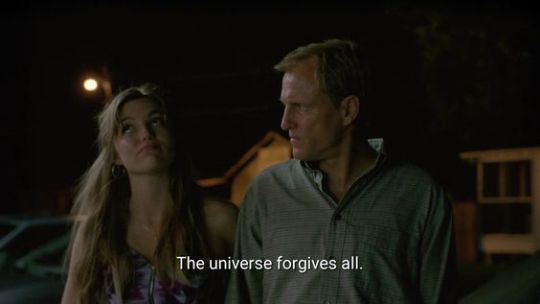
#or don't even ignore god knows i like marty the way he is. somehow#me and the “this too shall pass” insane bitch i pulled with my “the universe forgives all” vibe#in a show where so much of the plot is engraved in nature & the visuals are so green + it kind of ends with rust looking into a cosmic void#then i suppose this line gets even more meaning. it all rots into nothingness and forgives all#true detective
25 notes
·
View notes
Text
10 Lessons on Realistic Worldbuilding and Mapmaking I Learned Working With a Professional Cartographer and Geodesist
Hi, fellow writers and worldbuilders,
It’s been over a year since my post on realistic swordfighting, and I figured it’s time for another one. I’m guessing the topic is a little less “sexy”, but I’d find this useful as a writer, so here goes: 10 things I learned about realistic worldbuilding and mapmaking while writing my novel.
I’ve always been a sucker for pretty maps, so when I started on my novel, I hired an artist quite early to create a map for me. It was beautiful, but a few things always bothered me, even though I couldn’t put a finger on it. A year later, I met an old friend of mine, who currently does his Ph.D. in cartography and geodesy, the science of measuring the earth. When the conversation shifted to the novel, I showed him the map and asked for his opinion, and he (respectfully) pointed out that it has an awful lot of issues from a realism perspective.
First off, I’m aware that fiction is fiction, and it’s not always about realism; there are plenty of beautiful maps out there (and my old one was one of them) that are a bit fantastical and unrealistic, and that’s all right. Still, considering the lengths I went to ensure realism for other aspects of my worldbuilding, it felt weird to me to simply ignore these discrepancies. With a heavy heart, I scrapped the old map and started over, this time working in tandem with a professional artist, my cartographer friend, and a linguist. Six months later, I’m not only very happy with the new map, but I also learned a lot of things about geography and coherent worldbuilding, which made my universe a lot more realistic.
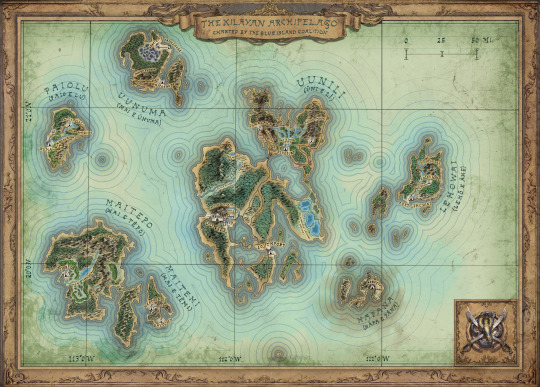
1) Realism Has an Effect: While there’s absolutely nothing wrong with creating an unrealistic world, realism does affect the plausibility of a world. Even if the vast majority of us probably know little about geography, our brains subconsciously notice discrepancies; we simply get this sense that something isn’t quite right, even if we don’t notice or can’t put our finger on it. In other words, if, for some miraculous reason, an evergreen forest borders on a desert in your novel, it will probably help immersion if you at least explain why this is, no matter how simple.
2) Climate Zones: According to my friend, a cardinal sin in fantasy maps are nonsensical climate zones. A single continent contains hot deserts, forests, and glaciers, and you can get through it all in a single day. This is particularly noticeable in video games, where this is often done to offer visual variety (Enderal, the game I wrote, is very guilty of this). If you aim for realism, run your worldbuilding by someone with a basic grasp of geography and geology, or at least try to match it to real-life examples.
3) Avoid Island Continent Worlds: Another issue that is quite common in fictional worlds is what I would call the “island continents”: a world that is made up of island-like continents surrounded by vast bodies of water. As lovely and romantic as the idea of those distant and secluded worlds may be, it’s deeply unrealistic. Unless your world was shaped by geological forces that differ substantially from Earth’s, it was probably at one point a single landmass that split up into fragmented landmasses separated by waters. Take a look at a proper map of our world: the vast majority of continents could theoretically be reached by foot and relatively manageable sea passages. If it weren’t so, countries such as Australia could have never been colonized – you can’t cross an entire ocean on a raft.
4) Logical City Placement: My novel is set in a Polynesian-inspired tropical archipelago; in the early drafts of the book and on my first map, Uunili, the nation’s capital, stretched along the entire western coast of the main island. This is absurd. Not only because this city would have been laughably big, but also because building a settlement along an unprotected coastline is the dumbest thing you could do considering it directly exposes it to storms, floods, and, in my case, monsoons. Unless there’s a logical reason to do otherwise, always place your coastal settlements in bays or fjords.
Naturally, this extends to city placement in general. If you want realism and coherence, don’t place a city in the middle of a godforsaken wasteland or a swamp just because it’s cool. There needs to be a reason. For example, the wasteland city could have started out as a mining town around a vast mineral deposit, and the swamp town might have a trading post along a vital trade route connecting two nations.
5) Realistic Settlement Sizes: As I’ve mentioned before, my capital Uunili originally extended across the entire western coast. Considering Uunili is roughly two thirds the size of Hawaii the old visuals would have made it twice the size of Mexico City. An easy way to avoid this is to draw the map using a scale and stick to it religiously. For my map, we decided to represent cities and townships with symbols alone.
6) Realistic Megacities: Uunili has a population of about 450,000 people. For a city in a Middle Ages-inspired era, this is humongous. While this isn’t an issue, per se (at its height, ancient Alexandria had a population of about 300,000), a city of that size creates its own set of challenges: you’ll need a complex sewage system (to minimize disease spreading like wildfire) and strong agriculture in the surrounding areas to keep the population fed. Also, only a small part of such a megacity would be enclosed within fantasy’s ever-so-present colossal city walls; the majority of citizens would probably concentrate in an enormous urban sprawl in the surrounding areas. To give you a pointer, with a population of about 50,000, Cologne was Germany’s biggest metropolis for most of the Middle Ages. I’ll say it again: it’s fine to disregard realism for coolness in this case, but at least taking these things into consideration will not only give your world more texture but might even provide you with some interesting plot points.
7) World Origin: This point can be summed up in a single question: why is your world the way it is? If your novel is set in an archipelago like mine is, are the islands of volcanic origin? Did they use to be a single landmass that got flooded with the years? Do the inhabitants of your country know about this? Were there any natural disasters to speak of? Yes, not all of this may be relevant to the story, and the story should take priority over lore, but just like with my previous point, it will make your world more immersive.
8) Maps: Think Purpose! Every map in history had a purpose. Before you start on your map, think about what yours might have been. Was it a map people actually used for navigation? If so, clarity should be paramount. This means little to no distracting ornamentation, a legible font, and a strict focus on relevant information. For example, a map used chiefly for military purposes would naturally highlight different information than a trade map. For my novel, we ultimately decided on a “show-off map” drawn for the Blue Island Coalition, a powerful political entity in the archipelago (depending on your world’s technology level, maps were actually scarce and valuable). Also, think about which technique your in-universe cartographer used to draw your in-universe map. Has copperplate engraving already been invented in your fictional universe? If not, your map shouldn’t use that aesthetic.
9) Maps: Less Is More. If a spot or an area on a map contains no relevant information, it can (and should) stay blank so that the reader’s attention naturally shifts to the critical information. Think of it this way: if your nav system tells you to follow a highway for 500 miles, that’s the information you’ll get, and not “in 100 meters, you’ll drive past a little petrol station on the left, and, oh, did I tell you about that accident that took place here ten years ago?” Traditional maps follow the same principle: if there’s a road leading a two day’s march through a desolate desert, a black line over a blank white ground is entirely sufficient to convey that information.
10) Settlement and Landmark Names: This point will be a bit of a tangent, but it’s still relevant. I worked with a linguist to create a fully functional language for my novel, and one of the things he criticized about my early drafts were the names of my cities. It’s embarrassing when I think about it now, but I really didn’t pay that much attention to how I named my cities; I wanted it to sound good, and that was it. Again: if realism is your goal, that’s a big mistake. Like Point 5, we went back to the drawing board and dove into the archipelago’s history and established naming conventions. In my novel, for example, the islands were inhabited by indigenes called the Makehu before the colonization four hundred years before the events of the story; as it’s usually the case, all settlements and islands had purely descriptive names back then. For example, the main island was called Uni e Li, which translates as “Mighty Hill,” a reference to the vast mountain ranges in the south and north; townships followed the same example (e.g., Tamakaha meaning “Coarse Sands”). When the colonizers arrived, they adopted the Makehu names and adapted them into their own language, changing the accented, long vowels to double vowels: Uni e Li became “Uunili,” Lehō e Āhe became “Lehowai.” Makehu townships kept their names; colonial cities got “English” monikers named after their geographical location, economic significance, or some other original story. Examples of this are Southport, a—you guessed it—port on the southernmost tip of Uunili, or Cale’s Hope, a settlement named after a businessman’s mining venture. It’s all details, and chances are that most readers won’t even pay attention, but I personally found that this added a lot of plausibility and immersion.
I could cover a lot more, but this post is already way too long, so I’ll leave it at that—if there’s enough interest, I’d be happy to make a part two. If not, well, maybe at least a couple of you got something useful out of this. If you’re looking for inspiration/references to show to your illustrator/cartographer, the David Rumsey archive is a treasure trove. Finally, for anyone who doesn’t know and might be interested, my novel is called Dreams of the Dying, and is a blends fantasy, mystery, and psychological horror set in the universe of Enderal, an indie RPG for which I wrote the story. It’s set in a Polynesian-inspired medieval world and has been described as Inception in a fantasy setting by reviewers.
Credit for the map belongs to Dominik Derow, who did the ornamentation, and my friend Fabian Müller, who created the map in QGIS and answered all my questions with divine patience. The linguist’s name is David Müller (no, they’re not related, and, yes, we Germans all have the same last names.)
#enderal#dreams of the dying#worldbuilding#resource#writeblr#writing tips#mapmaking#cartography#illustration#realism#writeblogging#novelwriting#writing research#research#writing
787 notes
·
View notes
Text
Stuff I read (and liked) this year
As promised, here’s a list of the novels, comics, manga, etc... I read this year, focusing on the ones I enjoyed and would recommend to people. Under a cut, this is going to be a little long.
-------- Books --------
Favorite book of the year: Stranger in the Woods, by Michael Finkel
Non-fiction. Based on the interviews of the man himself by the author, it is about a man who felt so unfit for society he decided one day to leave it, and spent the next 28 years as a hidden hermit in forest in Maine. The book details how he survived there, how he was eventually found, and some of his reasons for doing so. It’s a great reflection on the nature of loneliness.
Indian creek, by Pete Fromm
...Yet another detailed tale of living alone in the woods. This time, the diary of a student who spent a winter in the mountains to help tend for salmon hatchlings, and how he spent the rest of his days hiking, hunting, meeting the locals. It’s a fun little book who, being set almost the whole world away from where I live, was a nice way to travel.
Howl’s Moving Castle, by Diana Wynne Jones
I don’t feel the need to explain this one since everyone and their mom has seen the movie adapted from it. The book, that I first read a decade ago before I actually watched the film, is a less romantized, more spirited telling of the same story. The writing is absolutely delightful and so is the world it paints, and it’s the first time in ages a book had me laughing out loud during my entire read.
-------- Comics (BD) --------
Favorite comic of the year: Monsieur Désire?, by Hubert and Virginie Augustin
A discreet young woman becomes a maid for a decadent, unbearable, byronesque young lord. Caked in the rigid and oppressive social hierarchy of the victorian era, you follow a mental and verbal joust between the two, as the lord tries his best to offend and corrupt his new unrelenting servant, to little success. The writing and especially the dialogues were stellar, drawing me into the tense atmosphere, watching this trainwreck of a character flamboyantly destroy himself. While there’s no precise content warnings that I can give, this is a mature and heavy story.
World of Edena, by Moebius
Anyone who’s followed this blog for over a month knows how much of a Moebius fan I am. Edena combines the vague, dreamlike, wordless storytelling from stuff like Arzach or The cat’s eyes with an actual plot. While I haven’t completly finished the story, the evolution of the main characters and how the story is told have been great to read through, and as always the art is beyond gorgeous. Unfortunately suffers from some good old sexism in the writing that even if minimal, tasted sour
Le roman de Renart, by Joan Sfar (book 1)
Sfar’s work always has a signature vibe of being dreamy and light without being light hearted, of being down to earth but drifting in the fantastical, and this one is no exception. It’s an adaption of a series of medieval folk tales I grew up with, who uses the same characters to tell an original story. If you’re familiar with icons like Renart as well as other mythological big boys like Merlin you’ll fit right in. There is something special in how the dialogues are written, who feel natural in a way that you’d overhear in a street corner and is very special to me.
The mercenary, by VIncente Segrelles
Another one I post about a lot on this blog. The mercenary is a king on the throne of fantasy cheese. The worldbuilding is interesting at times but the writing is a pretty pathetic display of glorious old time sword and sorcery sci-fantasy 10 years too late for it’s prime (warning for ye old sexism and orientalism that plagues the genre, cranked very high...) but you come and stay for the art. The entire thing is drawn in a series of hyper detailed oil paintings with an insane eye for technical detail, from the engineering of the weaponry, to the architecture and weather, to the anatomy of the fantasy creatures... Each panel stands out as it’s own painting which makes even flipping through it without reading the scenario a treat. Click here to see more of the art, in my Segrelles tag.
The ice maurauder, by Jacques Tardi
A short story about mad scientists entirely drawn like a 19th century engraving. In great Tardi tradition everyone is ugly and mean, it ends terribly, it’s both a hommage to the genre of late 19th cent. to early 1900s dramatic adventure novels and a critical eye on it, and it’s morbidly funny. Most people I saw online hated the way this was written but I’m not them and I really recommend this book. Die mad
-------- Manga --------
Favorite manga of the year: it’s a tie between the following two.
Cats of the Louvre, by Taiyo Matsumoto
Most wonderful comic I have read in ages. The story follows a bunch of semi-feral cats secretly living in the Louvre museum’s attic, and the small group of humans who share their life, walking through the museum as the night watch. When the cats are together, they are represented in a humanoid way, but still act like animals, and “become” cats again when a human is nearby. The plot is a sort of supernatural mystery centered around a kitten who walks around paintings. It’s a love letter to art, sincere and beautiful, with a unique art style and great characters.
Memoirs of amorous Gentlemen, by Moyoco Anno
A sex worker in early 20th century paris starts writing down a diary of the clients she meets, in a quest to cope with the troubles of her life. You follow her, her colleagues, and her bittersweet relationship with an abusive lover. I don’t have much words about this comic, but the art and writing both are amazing, it’s the perfect length and drew me in like little series had before. Obvious content warnings as this is an adult story that talks about sexuality, but also depicts both mental and physical abuse.
Hana, also by Taiyo Matsumoto
A very short story, this was not made to be read as a comic originally, but served as storyboarding and visual development for a play, and the way it is written follows that. Hana is a slice of life story set in a fantasy world, of a young boy, his family, his village. Despite the setting being an original one, the character interactions are refreshingly... normal, and there is no huge plot to speak of, just a bit of the life of these characters. The art is beautiful, entirely black and white, with a scratchy style and an emphasis on contrast. Matsumoto is on a speedy road to becoming my favorite manga artist haha
Delicious in Dungeon, by Ryoko Kui
While not marked as my year’s favorite, I still consider this series among my favorite manga ever. The art and writing are amazing, and it’s both heartfelt, well concieved and plain hilarious. The story follows several parties of dungeon diving adventurers each on their little quests with a premise of our protagonists, on a panic rescue mission, surviving in the dungeon by cooking and eating the monsters they come across. From a DnD party turned cooking manual dinner of the week beginning, the plot creeps up on you and slowly thickens. I don’t want to spoil anything about the overarching story of this because it was a delight to discover for myself. While everything about DinD rules, I am especially fond of the design philosophy of the author, who puts great detail in the practicality and biology of what she draws, as well as the character writing. Everyone even side characters has so much charm and depth to them, the cast is so diverse and entertaining...! Each character is just a bit lame enough but endearing, and has their own little backstory that shows in the way they exist. It’s a delight
Chainsaw man, by Tatsuki Fujimoto
I went into CSM expecting a borderline campy hyperviolent dumb fun thing to read and was very surprised to find an uncomfortably well written story about a teenager being groomed. The hyperviolent dumb fun fights are here nonetheless and the series still qualifies as shonen for some reason, but the more mature character writing as well as some truly outlandish visuals make it something very special. If you can’t stand shonen, not sure you will like it, but if you don’t mind it, worth trying.
Witch hat atelier, by Kamome Shirahama
The oh so elegant fantasy seinen every cool kid started posting about this year, who I also succumbed to and fast. Witch hat is hard to explain, as most of it’s plot revolves around the rules of the world it’s set in, specifically the regulations around it’s magic and the social and historical reasons for them. It’s about growing up, learning, disability, making art. You follow a little girl taken in by a witch as an apprentice, her magical education, and learn little by little why her lovely teacher is so willing to break a lot of rules... While a bit too gentle and pretty for my taste at times, Witch hat has great worldbuilding and explores sensitive themes I rarely see in manga, much less in fantasy. And Berserk wishes it had art this good
24 notes
·
View notes
Text
kamen rider OOO review
a young man, having dozed off a night on security guard detail, awakens to find an odd red coin engraved with a bird motif. assuming the coin is payment for his work, he goes to change into his civilian clothes and oh fuck there’s a giant hole in the wall.

after a quick police interview revealing that our hero 1. is thoroughly naive and 2. has an unusual fixation with underwear, he puts his clothes on and goes to spend his “payment” in a vending machine and--whoops, dropped the coin under the machine. fortunately, a very strong (and CUTE) young lady is nearby to help lift up the machine...and nearly drops it when they see the monstrous disembodied arm crawling out from beneath! then the arm, who can talk and has a terrible personality, starts giving underwear boy orders. oh yeah, and i totally forgot to mention the opera rendition of “happy birthday” played over a bunch of weird monsters terrorizing civilians as a snappily dressed executive decorates a birthday cake on his office desk.
welcome to the world of kamen rider OOO! (pronounced “ohs”--like cheeri”os”.)

^ oh, the sexual tension.
plot: there’s two other fictional worlds that OOO has brought to mind for me multiple times. the worldbuilding and unique magical elements of OOO combined with a heaping cupful of absurdity and a pinch of homoeroticism reminded me quite a bit of jojo’s bizarre adventure--crazy and ridiculous stuff happens, but it’s built up in such a way that you generally understand enough of what’s going on that it isn’t too confusing. furthermore, the themes of desire, evolution, beginnings, endings, and nihilism bring to mind the dilemmas at play in the shin megami tensei games--many of the platitudes expressed in OOO could’ve easily been quoted from lucifer...and others from smtiv’s white. you’ll want to learn the truths. you’ll want to see what happens next.
characters: despite what ankh may claim, this show is not about him, as evidenced by the fact that its title is not bird greed ankh. he sure is a Character, though. heisei kamen rider is great at giving its viewers morally iffy or outright bastardy characters so unique and interesting that you wind up cheering for as much as if not more than for the heroes, and ankh is a primo example of this.
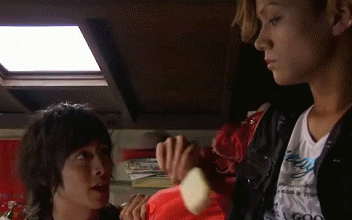
i love him, but also fuck that guy.
eiji hino definitely fits into the tradition of himbo tokusatsu protagonists. he’s not a complete dumbass so much as he is a pollyanna. like others in said tradition, he’s endearing, and i believe in him. you learn a lot about him over the course of the story, and how you see him closer to the end may surprise you.
the cast is colorful and fun. hina izumi, the super strong girl from earlier, becomes inexorably entwined in this drama of medals and monsters when her beloved older brother shingo winds up possessed. shintaro gotou, a former police officer, now works on behalf of the mysterious kougami foundation with the aim of fighting evil and protecting the innocent--but isn’t so sure how he’s going to do so. akira date, a roguish bad boy doctor and self-professed slave to desire, takes on a very special job to fulfill his goal of earning 100,000,000 yen. more oddballs can be found in service of the kougami foundation as the story continues...
oh, and the greed. or greeed. i’ve seen it both ways. i believe i’ve said a bunch of times before that i like a toku series with good fucking villains--you learn who they are and what drives them, you get how what they’re doing fulfills those goals, and you see how they relate to those around them beyond the customary shit-talking of the heroes. not only that, but the greed are a novel concept with fascinating aesthetics. i greatly enjoyed learning their secrets.
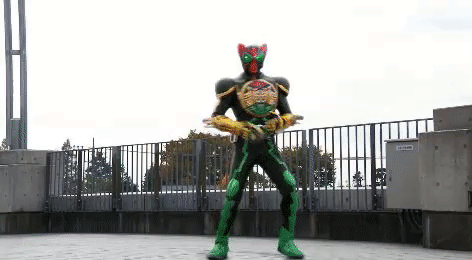
fights: instrumental to every battle is the abilities OOO has access to, which are determined by the medals he has in his possession--ancient coins which act as the DNA of the greed, and grant OOO different animal-themed powers. he equips the cheetah medal, and he can move at great speeds. he equips the hawk medal, and he can see great distances. naturally, such powerful artifacts are in high demand--OOO and the greed are constantly stealing them from each other, meaning what he’s capable of can vary greatly from episode to episode. only being able to switch out different hands is so 1980.
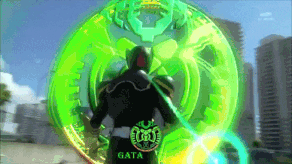
abilities that change again and again throughout the series make for some awesomely unique fights. mix that up with the various greed and the unique monsters they create using the power of human desire--yummies--and the fights don’t get dull.
visuals: the fact that i started watching kamen rider w with @shylax while still watching OOO made me notice something interesting: OOO appears to be the point that neo-heisei kamen rider became the bright shiny lightshow we see today in zi-o. w, while not visually lacking, still has the sort of drab, overcast quality to it that i’ve also noticed in ryuki and decade. i don’t know the technical terms needed to describe this phenomenon more accurately--just that something changed in 2011, and kamen rider really brightened up.
OOO’s suit forms are colorful and bold. many of the characters are associated with color motifs. cous coussier, the eccentric costume cafe that becomes eiji’s base of operations, is constantly switching up its theme and outfits. and as always, toei provides lots of visually striking sets.
music: the unusual opening theme, “anything goes”, will definitely make an impression; i initially found it weird, but damn, it gets me fired up now. strong inserts and moving incidentals are included too. “anything goes”, along with inserts “time judged all” and “reverse re;birth” have their own music videos, the latter two featuring the characters singing.

if you actually read all that, it should come as no surprise that i had a blast watching kamen rider OOO and highly recommend it. kobayashi knocks it out of the goddamn park once again!
as for my next series...i’m looking at a few possibilities. kamen rider 555 is one, as it’s a series @shylax definitely enjoyed. i’m also curious about other yasuko kobayashi series, seeing as they’ve proven great investments of my time so far. i’ve also grown curious about metal hero after seeing the new space sheriff gavan on kyuranger, though i’m at a loss for where i’d start with it. in the meantime, however, i’m going to watch the OOO movies!
26 notes
·
View notes